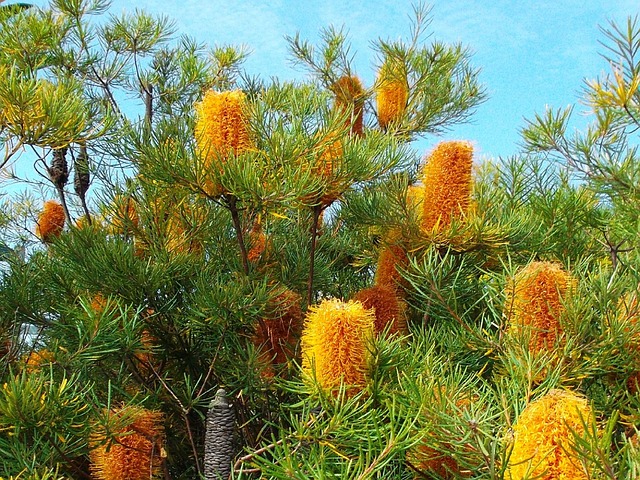
Soon after I became a teacher, I was pleased to learn of an aboriginal plant-use trail in the National Botanic Gardens. So of course I hied me to the Gardens, with various classes in tow, to teach them the rudiments of not just botany but survival in the bush and indigenous understandings of such.
This trail has been much adapted and improved since I began to use it (some 20 years ago) but one year a particular plant was conspicuous by its absence. There was a sign, but no plant.
On inquiring about this absence, I was told that the plant not only had medicinal value, but also hallucinogenic properties. It had not been removed by the staff, but by enterprising members of the public who wanted to get high! Thereafter the sign was also removed and no hint of such plants now exist in the public view.
What’s more, there is NOW a sign on the trail that says PLEASE DON’T PICK OR EAT THE PLANTS.
You don’t have to starve in the bush!
But you do have to understand what you’re looking at and how it can be used.
For example, lemon myrtle, Backhousia species, has beautiful aromatic leaves which can flavor your food, but you shouldn’t actually eat the leaves – take them out after they’ve infused. This tree also has licorice and curry flavours.
The cherry ballart, Exocarpus species, has a tasty red berry in season. The prickly currant bush, Coprosma species, produces a small sweet red fruit. The mountain pepper, Tasmannia species, has black seeds that are very peppery, but the leaves are somewhat milder in taste, although they still have a bite! Native raspberry, Rubus species, looks much like our familiar raspberries, though the fruit is smaller and you must contend with the prickles.
Both Banksia cones and Melaleuca flowers can be used to sweeten water for drinking. The bark of the Melaleuca, also called the paperbark, is useful for sealing eels and fish among coals for cooking.
Many Acacias have edible seed pods that can be ground to make flour. Some even have edible bark. River she-oaks, Casuarina species, also have seeds that may be crushed into a paste and eaten.
Kurrajongs, Brachychiton species, store water in the roots and trunk. Young shoots can be eaten, usually roasted, and seeds can be eaten raw or roasted after the bristly coating is removed.
The flower spike of grass trees, Xanthorrhoea species, can be soaked in water to make a sweet drink, and the soft white leaf bases, as well as the growing point of the flower stem, can be eaten.
Surprisingly, the fruits of some mistletoe species such as Muellerina and Amyema species, can also be eaten, but they are very sticky. They are high in protein, carbohydrates and lipids and are often available when there is a lack of other edible vegetation.
The stems, leaves and seeds of many grasses, such as kangaroo grass, Themeda species, are also edible but tedious to harvest.
More accessible are the roots and tubers of forbs such as milkmaids, Burchardia species, and various orchids, such as Gastrodia, Pterostylis and Dipodium species. The tubers of the yam daisy, Microseris species, are best eaten roasted, which improves the flavor.
Medicinal plants
Every culture has a “cure-all”. For Ngunnawal people this is considered to be the old man weed, Centipedia species. It can be crushed or sniffed to relieve cold symptoms, or a solution can be made to treat eye or skin infections. It has apparently been used to treat arthritis and tuberculosis in some areas.
The resin of black cypress pine, Callitris species, can be used for medicine and to make glue. The sap of the cherry ballart is also used as an effective medicine for snake bites. Grass tree resin can be used for skin complaints as well as glue for the manufacture of weapons and stone axes.
The leaves of the narrow-leafed hopbush, Dodonea species, can be chewed to relieve toothache, as can the juice of the boiled leaves. Mint bush, Prostanthera species, was used by early settlers to relieve colds and chest infections, but limited information is available about that.
Multi tasking plants
Many Acacia species have multiple purposes. For example the blackwood, Acacia melanoxylon, has edible seeds, while its leaves may be used as soap (sometimes the source of the froth we see in mountain streams where there is little external means of pollution). The bark, when heated and infused in water, can be applied to relieve sore joints. The timber can be used for clap sticks, spear throwers and shields and string can be made from the bark. When the leaves are mixed with water they can make a fish poison.
The mat-rush, Lomandra species, is a truly multi-purpose plant. The roots are used to treat bites and stings. The leaves are used to weave baskets, mats, string and fish traps. The white leaf base can be chewed to provide a sweet, starchy meal and the seeds, which are high in protein, can be ground into flour.
Many Eucalyptus species are used for antiseptic and cleaning purposes. The wood of these and other trees are used to make weapons, canoes and other tools.
Poison plants
When the leaves and roots of Austral indigo, Indigofera australis, are crushed and put in pools of water, they stun and disable fish so they are easily caught. A number of plants are poisonous and the key to using them is to know how to extract the toxins before using them for food.
I strongly advise you to seek advice from a botanist or indigenous expert before you try to eat any of these.
Indeed, the earth is the Lord’s and His provision is bountiful!
This is just a small snapshot of the richness of the Ngunnawal people’s use of local plants. And I have not found out the name of the hallucinogenic plant – apologies for that!
References
Ngunnawal Plant Use - A Traditional Aboriginal plant use guide for the ACT region. 2014, ACT Government.
Personal communications, 2018, Australian National Botanic Gardens.

Aira Chilcott is a retired secondary school teacher with lots of science and theology under her belt. Aira is a panellist for Young Writers and indulges in reading, bushwalking, volunteering at a nature reserve and learning to play clarinet. Aira is married to Bill and they have three adult sons.
Aira Chilcott's previous articles may be viewed at http://www.pressserviceinternational.org/aira-chilcott.html

Aira Chilcott is a retired secondary school teacher with lots of science andtheology under her belt. Aira is an editor for PSI and indulges inreading, bushwalking and volunteering at a nature reserve. Aira’s husband Bill passed away in 2022 and she is left with three wonderful adult sons and one grandson.
Aira Chilcott's previous articles may be viewed at http://www.pressserviceinternational.org/aira-chilcott.html